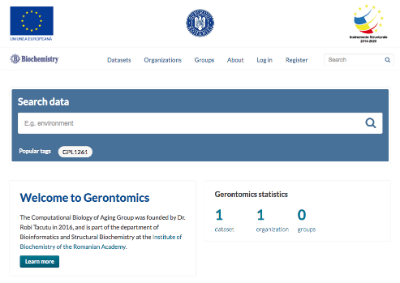

multi-disciplinary lab, awesome international team, cool tools and models
Multi-omics prediction system for prioritization of gerontological interventions
Starting 02.09.2016, the Institute of Biochemistry of the Romanian Academy is implementing the project “Multi-omics prediction system for prioritization of gerontological interventions”, co-funded through European Fund for Regional Development, in accordance with the funding contract signed by the Ministry of National Education and Scientific Research.
The total funding for the project is 8.524.757,50 lei, of which 8.502.557,50 lei represent non-reimbursable funding. The project’s duration is 48 months.
The general strategic goal of the project is in accordance with the objectives and priorities of the 2014-2020 Competitiveness Operational Programme – Priority Axis 1 – Research, Technological Development and Innovation (RD&I) to support of Economic Competitiveness and Business Development – Action 1.1.4 Attracting high-level personnel from abroad in order to enhance the RD capacity.

We are currently developing a dataset portal for the Gerontomics data. This will include the hosting of all the datasets potentially of interest (both raw and processed data), tools for their integration, analysis pipelines and the interface to our machine learning module. More news soon. Stay tuned! To access the portal in its current form, please click here (limited access for developers).
The aging of the population (i.e., the increase in average lifespan) is one of the major biomedical problems, challenging us nationally and also internationally. This increase in lifespan, which is mostly due to improvements in the healthcare system and is to be applauded, does not necessarily guarantee healthy aging and an increase in healthspan.
By integrating multiple aging models (from different species and various experimental models), which capture holistically the differences between the „normal” and „unbalanced” states of the biologic system, the project aims to analyse with an improved accuracy the mechanisms that lie behind aging. Such an approach is promising for the understanding of the multiple facets of aging, including ways to extend healthspan, by minimizing the statistical noise intrinsic to any individual screening.
From a technological point of view, the employed methods in this project (integrative multi-models, large-scale data analysis, network-based analysis methods, deep neural nets) are modern and represent the state-of-the-art in the field. The project is computationally intensive and will result in the development of new algorithms, statistical metrics and in the application of AI and machine learning methods to biological problems. By doing a holistic analysis of genomics, transcriptomics, epigenomics and GWAS datasets from humans and model organisms the project has the applicative aim to enhance our understanding of the biology of aging, with the final goal to create an integrative, multi-omics prediction platform for prioritization of gerontological interventions.
Destined mainly for research organisations, but also for pharmaceutical companies focused on aging research, we expect that the final product of this project will help reduce research costs (both financial and time-related), encourage aging research and channel experimental gerontological studies (in vitro or with animal models) towards a higher efficiency. Overall, the project will contribute directly by generating fundamental knowledge in aging research. From this point of view, both cost reduction in gerontology and generating new hypotheses about aging are areas of great interest for the „Healthy aging, lifestyle and public health” direction, one of the current priorities of the healthcare system. In particular, the study of aging will contribute to the development of preventive therapies, which target lifespan extension, and more importantly healthspan (defined as the active, healthy and productive period in a person’s life). Both objectives have the potential to greatly impact the life quality in our society, and in particular for the elderly.